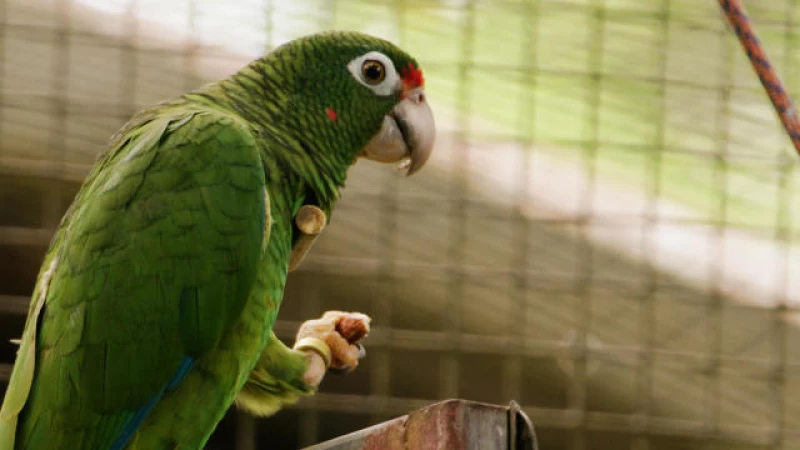Before Hurricane Maria in 2017, there were 56 wild, endangered Puerto Rican parrots living around El Yunque National Forest. However, after the storm, only one parrot survived the devastation.
"I'll admit that a couple of times I just cried," shared Tom White, a biologist with the U.S. Fish and Wildlife Service, who has dedicated 30 years to re-establishing a wild Puerto Rican parrot population at El Yunque.
The Puerto Rican parrot is considered one of the most critically endangered birds globally, as stated by the International Union for Conservation of Nature and Natural Resources.
Approximately 60 years ago, the U.S. Fish and Wildlife Service classified the parrot as an endangered species, initiating a continuous and challenging endeavor to rebuild a thriving population of parrots in the wild, a mission that persists today.
"If human beings have caused it, it is basically incumbent upon us to fix it," emphasized White.
However, the Puerto Rican parrot is just one of the numerous species whose habitat and existence are jeopardized by hurricanes, which are increasingly more and more destructive due to climate change.
Hurricane Maria claimed the lives of nearly 3,000 individuals, leading to unprecedented floods and landslides. Recent research has revealed that the extreme rainfall associated with Maria was 5 times more likely due to the effects of climate change.
During the storm, White and his wife sought refuge in a hurricane shelter along with 120 pairs of parrots they were caring for. Despite enduring 175 mph winds, they managed to protect the birds. Once the storm passed, they were shocked by the devastation they witnessed.
"The transformation from vibrant greenery to a barren landscape happened within a matter of hours," White expressed.
Although the captive parrots survived, the fate of 56 wild parrots that had been released prior to the storm remains unknown as rescue crews were unable to reach them due to heavy debris.
In the aftermath of the hurricane, some of the wild parrots perished due to the strong winds, but a larger number succumbed to starvation as the forests on the island were stripped of vegetation.
"The lack of food sources left them with no option," explained Marisel López Flores, who leads the Parrot Recovery Program.
A Global Crisis for Birds
The plight of birds is a growing concern worldwide, encompassing not only exotic species but also those native to various regions. According to the National Audubon Society, nine bird species in North America have vanished in the last 400 years. The organization predicts that 314 bird species are at risk of extinction within this century if immediate actions are not taken.
According to a groundbreaking study conducted by the Cornell Lab of Ornithology, some of the most significant declines in bird populations have been observed in the most common bird species. The study, which analyzed data from 1970 to 2019, revealed alarming losses in various bird populations:
- Wood thrushes, commonly found across the eastern U.S., have seen a 60% decline.
- Baltimore orioles, another eastern bird species, have lost two-fifths of their population.
- Western meadowlarks, prevalent in the central and western U.S., have experienced a three-fourths reduction in numbers.
Major threats to bird populations stem from habitat loss, global temperature rise, and more intense hurricanes. While many bird species have evolved to withstand severe storms, the destruction of their habitats for nesting, foraging, and roosting poses a significant challenge, as seen in the case of the Puerto Rican parrots.
Conservationist White emphasized that safeguarding the habitats of parrots can also benefit thousands of other species by preserving crucial ecosystems.
"By doing so, you protect the world for many others at the same time," he remarked.
Giving the birds a better chance
In the aftermath of Hurricane Maria, the U.S. Fish and Wildlife Service has been successful in reintroducing a wild population of parrots, but with a new approach. Previously, the birds were released in remote areas of El Yunque. Now, scientists and staff employ behavioral techniques to encourage the birds to remain in proximity to the aviary complex.
Essentially, this combines wild and captive birds into a single community at the aviary. In future disasters, this may give the birds a better chance of being rescued and fed when the forest is impassable.
Biologists developed this technique at a sister parrot aviary in Puerto Rico, at Rio Abajo State Forest, where, after Maria, they were able to feed 90 birds and save their lives. The techniques developed in Puerto Rico have since also been successfully used in the release of endangered macaws in Brazil.
Tom White, the U.S. Fish and Wildlife biologist, said birds survive better with larger flock sizes.
"Flocks defend against predators and also to better find food resources," White said.
In January, the aviary in El Yunque released 22 birds from captivity. Between three aviary locations across Puerto Rico, today there are about 300 parrots living in the wild, a sign that the parrot recovery efforts here are working.
"When I'm old and I die, I can say I did something for my country. This is the way I think I'm contributing to my island," said López Flores.







